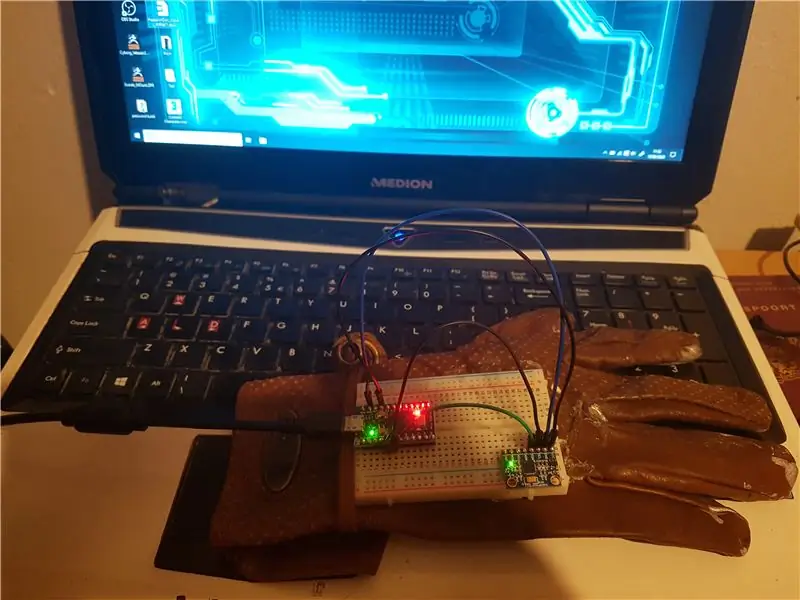
Sommario:
- Autore John Day [email protected].
- Public 2024-01-30 10:01.
- Ultima modifica 2025-01-23 14:49.

È possibile utilizzare un controller di movimento per gli sparatutto su rotaia. L'espediente del progetto è tutto ciò che è il controllo del movimento, inclusi gli schietti. (Je schiet door te "finger bangen")
Passaggio 1: Het Materiaal
Het materialeal dat je gaat nodig hebben is vrij simpel. 1x Arduino pro micro di Arduino Leonardo1x giroscopio MPU6050
4x cavi
Fase 2: De Bekabeling

Zoals je in het schema in de afbeelding ziet is de bekabeling super simple. MPU VCC > Arduino VCCMPU ground > Arduino groundMPU SCL > Pin 3MPU SDA > Pin 2
Passaggio 3: Librerie 1

Per qualsiasi progetto heb je een paar custom library nodig van deze link:
Scarica un file ZIP tramite il pulsante "Clone or download" rechts bovenaan.
Passaggio 4: Librerie 2

Apri il file zip e clicca sulla mappa "Arduino". En uit deze Arduino map wil je de mapjes "I2Cdev" en "MPU6050" pakken en in je Arduino library zetten (Programmi > Arduino > librerie)
Passaggio 5: codifica del codice
#includere
#include #include #include #include
MPU6050 MPU;
int16_t ax, ay, az, gx, gy, gz;
int16_t accx, accy, accz; int vx, vy; angolo di flottazione;
//codice per livellare inputint readIndex = 0; const int numLetture = 20; int angoloLetture[numLetture]; int totale = 0; float medioAngolo = 0.0;
int oldZ = 0;
int nuovaZ = 0;
void setup() { Serial.begin(115200); Wire.begin(); Mouse.begin(); mpu.initialize(); if (!mpu.testConnection()) { while (1); }
for (int thisReading = 0; thisReading < numReadings; thisReading++) { angleReadings[thisReading] = 0; } }
ciclo vuoto() {
totale = totale - angleReadings[readIndex];
angleReadings[readIndex] = angolo; totale = totale + letture angolo[readIndex]; readIndex = readIndex + 1; if (readIndex >= numReadings) { readIndex = 0; }
if (gz > 30000) { Serial.println("Bang"); Mouse.click(); //Spara muovendo la pistola all'indietro (sbattendo le dita) }
//accx, accy, accz;
mpu.getMotion6(&ax, &ay, &az, &gx, &gy, &gz); mpu.getAcceleration(&accx, &accy, &accz); //Serial.println(gy); // Serial.println(angolo);
vecchiaZ = nuovaZ;
vx = (gx + 1000) / 150; vy = -(gz - 200) / 150; Mouse.move(vx, vy); ritardo(20);
Dit stukje code heeft een beetje uitleg nodig omdat je het waarschijnlijk een klein beetje moet aanpassen.
Water waarschijnlijk gaat gebeuren is dat je cursor uit zichzelf over je scherm gaat bewegen (van rechts naar links, van boven naar onder of diagonaal) en dit stukje code zorgt er voor dat je curor stil sblijeft input Je moet de values in in "gx + 1000" en "gz - 200" aanpassen totdat je het resultaat krijgt dat je wil en ik denk dat de values die wil nodig hebt afhankelijk zijn van je scherm relutie. Als de cursor uit zichzelf van rechts naar links beweegd wil je "gx + x" aanpassen. Als de cursor uit zichzelf van boven naar beweegd wil je de "gz - x" aan passen. Als het diagonaal beweegd, dan kies je een van de twee valori om aan te passen totdat hij nog maar over een as beweegd en dan pas je de andere aan.
Serial.print("gx = ");
Serial.print(gx); Serial.print(" | gz = "); Serial.print(gz); Serial.print(" | gy = "); Serial.println(gy); if (gx > 32000) { Serial.println("Scorri verso destra"); //Ricarica quando muovi la pistola a destra Keyboard.write('r'); ritardo(250); } Serial.print("accx = "); Serial.print(accx); Serial.print(" | acci = "); Serial.print(accy); Serial.print(" | accz = "); Serial.println(accz); //lavoro //angolo = atan2((float) (ay - 16384), (float) (ax - 16384)) * (180.0 / PI) * -1; angolo = atan2((float) ay, (float) ~ax) * (180.0 / PI); //float angle = atan2((float) ay, (float) -ax) * (180.0 / PI); //Serial.println(averageAngle); }
Consigliato:
ITTT: "Zingend Meisje": 5 passaggi

ITTT: 'Zingend Meisje': Istruzioni del progetto 'zingend meisje': Hier ga ik vertellen hoe jij zelf een zingen meisje kan maken met arduino. Wat houd het in?: Je gaat een meisje van hout maken die beide haar armen uitsteekt. Aan de ene arm zit een lichtsensor en aan de andere
ITTT L.E.D.: 3 passaggi

ITTT L.E.D.: Questo è un progetto scolastico per un corso chiamato If This Then That. La premessa del compito scolastico è realizzare un oggetto interattivo con l'uso dell'elettronica principalmente l'Arduino Uno. Dopo un lungo periodo di riflessione ho deciso di fare qualcosa
Arduino ITTT: 10 passaggi

Arduino ITTT: Dit is myjn arduino project:Het autotje wat van je wegrijdt as je ermee wil spelen, heerlijk om kinderen mee te plagen.in de volgende slides laat ik zien hoe ik te werk ben gegaan
Il labirinto di Sif (gioco) - Arduino ITTT: 4 passaggi (con immagini)

Sif's Maze (Gioco) - Arduino ITTT: La mia scuola mi ha incaricato di creare qualcosa di interattivo con un Arduino. Ho realizzato un piccolo gioco del labirinto, che, purtroppo, non è andato molto bene, ma sentiti libero di finirlo o aggiungerlo. Questo progetto è iniziato come un concetto per un TBA sulla mitologia norrena. io
ITTT Arduino Tamagotchi: 9 passaggi

ITTT Arduino Tamagotchi: Progetto HKU ITTT - Willem van schaik, 1D 3030057Voor dit project heb ik een virtual pet, vergelijkbaar with a Tamagotchi gemaakt. In questo istruibile zal ik toelichten hoe
